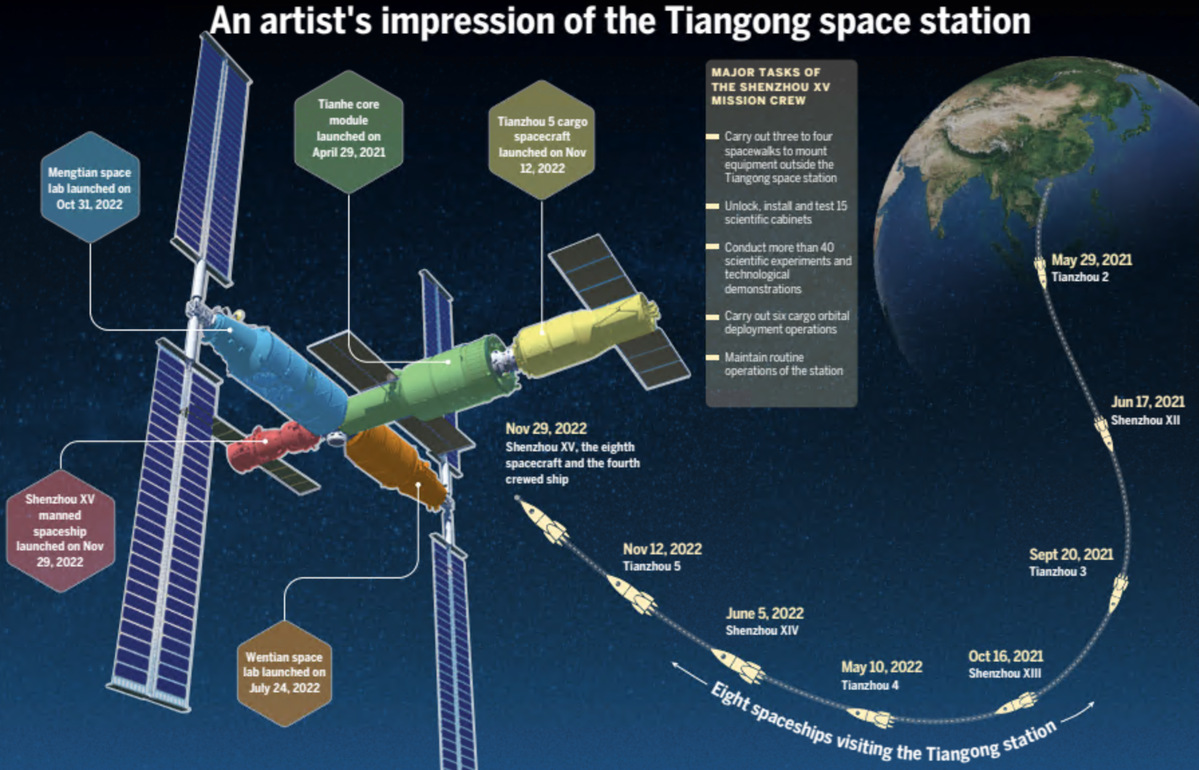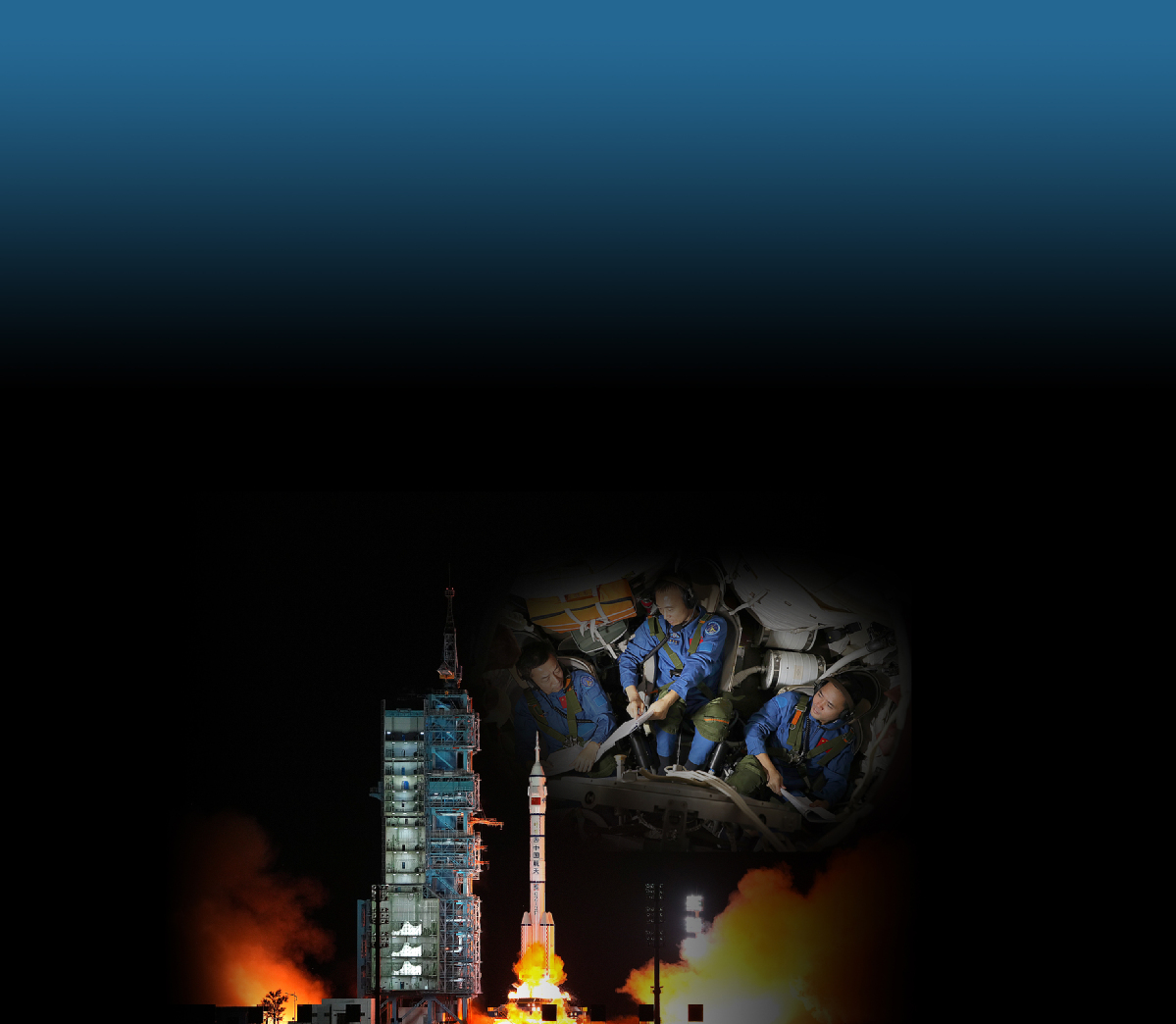Nation's space industry hits new heights

CHINA DAILY
Completion of Tiangong orbital hub highlight of busy year
China's space industry had a busy year in 2022, the highlight of which was completion of one of the world's largest and most sophisticated orbiting infrastructures, the Tiangong space station.
After traveling for 15 months in low orbit, about 400 kilometers above the Earth, Tianhe, the space station's core module, received its first long-term companion — the Wentian lab module — in late July.
Wentian lifted off on a Long March 5B heavy-duty rocket from the Wenchang Space Launch Center in Hainan province to become Tiangong's first scientific component.
Weighing 23 metric tons and with a length of 17.9 meters, Wentian carries eight scientific cabinets, which are mainly used for biological and life science studies, but can also support research on the growth, aging and genetic traits of plants, animals and microbes in space.
Wentian's exterior is equipped with extravehicular payload adapters that carry scientific equipment for experiments requiring exposure to space, cosmic rays, vacuums and solar winds.
In addition to its scientific functions, Wentian acts as a backup control station to the Tianhe module in case of emergencies or malfunctions. It has the same flight-control devices as Tianhe, as well as three separate sleeping quarters and an area for personal hygiene, enabling the entire Tiangong station to be operated via Wentian if necessary.
In late October, the second lab module — Mengtian — lifted off on another Long March 5B rocket to dock with Tianhe.
Mengtian, the world's largest single-body spacecraft in active service, carries 13 scientific cabinets for use in microgravity studies and experiments in fluid physics, materials science, combustion science and fundamental physics. It also has 37 extravehicular payload adapters.
A major technical feature of the spacecraft is that it can move scientific apparatus out of the Tiangong station — without any manual labor from the astronauts — to conduct extravehicular experiments, before returning with the apparatus.
Moreover, Mengtian's designers said it can send miniature spacecraft, such as CubeSats, into orbit. The addition of Mengtian marked the end of the in-orbit assembly process for the Tiangong station.
Four teams of astronauts have lived and worked on the space station, which now consists of the Tianhe module, the Wentian and Mengtian science capsules, the Shenzhou XV spacecraft and the Tianzhou 5 cargo ship.
The current crew — the three members of the Shenzhou XV mission — arrived at the station in late November. They worked with the three Shenzhou XIV astronauts, who had been aboard the station for almost six months, for four days before the latter team returned to Earth.

Right: The crew of Shenzhou XV prepares for the mission in a spacecraft simulator on Sept 1. [XU BU/FOR CHINA DAILY] Left: The Shenzhou XV spacecraft lifts off from Jiuquan, Inner Mongolia autonomous region, on Nov 29. [LI GANG/XINHUA]
The Shenzhou XV crew is scheduled to remain at the space station until May, before being relieved by members of the Shenzhou XVI mission.
In his annual New Year address on Dec 31, President Xi Jinping announced that the Tiangong station had been completed.
According to the China Manned Space Agency, Tiangong will serve as a national space-based platform for science and technology. It is expected to remain in orbit for more than 10 years, and will be open to astronauts from other countries in the near future.
Yang Yuguang, a senior space industry observer in Beijing and vice-chair of the International Astronautical Federation's space transportation committee, said that although the Tiangong station is much smaller than the International Space Station, it is more cost-effective.
"We spent much less than the sum needed to build and run the ISS. The steps we took (to construct the Tiangong station) were also simpler and easier than those required for the ISS. Nevertheless, Tiangong has a pretty strong capability to perform scientific experiments and technological tests through its cutting-edge equipment," Yang said.
Starting this year, members of the third group of Chinese astronauts are scheduled to take part in flights, officials from the China Manned Space Agency said. The 18 new astronauts — 17 men and one woman — are in three groups: seven spacecraft pilots, seven spaceflight engineers and four payload specialists.
They are undergoing systematic training at the Astronaut Center of China in Beijing, before being certified for spaceflights.
Launch records
In addition to the space station, China achieved another major space landmark last year by conducting 64 rocket launches, a national record.
Of the 64 liftoffs, 53 were completed by the Long March series of rockets. The Shanghai Academy of Spaceflight Technology carried out 30 launches, and the China Academy of Launch Vehicle Technology 23. Both are subsidiaries of China Aerospace Science and Technology Corp, the nation's leading space contractor.
It was the first time that China had conducted more than 60 rocket launches in a year. In 2021, it conducted 55 space launches, with the Long March series used for 48 of them.
The Long March 2D model, a product of the Shanghai academy, was used for 15 liftoffs last year, heading all Chinese rockets by number of annual flights.
Over the past year, two new Long March models conducted their first flights and entered service.
In late February, a modified version of the Long March 8 lifted off from the Wenchang Space Launch Center on its maiden flight to transport 22 satellites into orbit, a record for the most spacecraft launched by a single Chinese rocket.

Mengtian, the world's largest single-body spacecraft in active service. XINHUA
Before this mission, the nation's record for the most satellites launched by one rocket was held by the first flight of a Long March 6 in September 2015, which deployed 20 satellites.
Like the original Long March 8 model, the variant is 50.3 meters long and has a diameter of 3.35 meters. It is propelled by four engines — two on the first stage and two on the second — and has a liftoff weight of about 356 metric tons.
The rocket can transport satellites with a combined weight of 3 tons to sun-synchronous orbits. The major difference between the two models is that the new one does not have side boosters. Its fairing is also shorter than that of the original, according to the designers.
In late March, a Long March 6A made its first flight from the Taiyuan Satellite Launch Center in Shanxi province.
Developed by the Shanghai Academy of Spaceflight Technology, the 50-meter-long rocket is China's first to use liquid-and solid-propellant engines as its main form of propulsion.
With a liftoff weight of 530 tons, it is tasked with transporting satellites into different types of orbit, including sun-synchronous, low-Earth and intermediate circular.
Despite being named the Long March 6A, the new model is far different from the Long March 6, which was also designed and built by the Shanghai academy.
The Long March 6, which is about 30 meters high and weighs 102 tons, is much smaller and lighter than the new model. First launched in September 2015, it has carried out 10 flights.
Long Lehao, a top rocket scientist at the China Academy of Launch Vehicle Technology, said that about 27 percent of Long March flights last year were undertaken by new types of rocket developed in recent years.
"The fact that new-generation rockets have been widely used represents a big leap in our research, development and production capabilities in the carrier rocket field," he said.
In July, the rocket company CAS Space, which is based in Beijing and owned by the Chinese Academy of Sciences, carried out a successful debut flight of its ZK 1A rocket.
With a length of 30 meters, diameter of 2.65 meters and liftoff weight of 135 tons, the model is China's largest and most powerful solid-propellant rocket capable of sending satellites with a combined weight of 1.5 tons into a typical sun-synchronous orbit of about 500 km above Earth.
This year, the nation plans to carry out some 60 launch missions, including manned and robotic flights to the Tiangong space station and the maiden flight of the Long March 6C rocket, mission planners said.
Photos
Related Stories
- Looking forward to higher-level space cooperation with China: South African engineer
- China plans 60-plus space launches in 2023
- China's space-based solar camera publishes data on solar atmosphere
- Aerospace industry base starts operation in south China
- Shenzhou XV astronauts having fun in space exercises
- China aims to launch 60 space missions in 2023
Copyright © 2023 People's Daily Online. All Rights Reserved.









